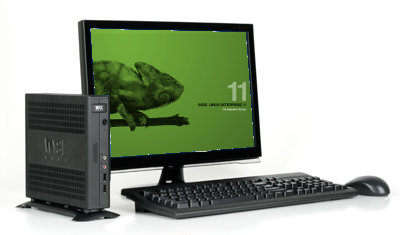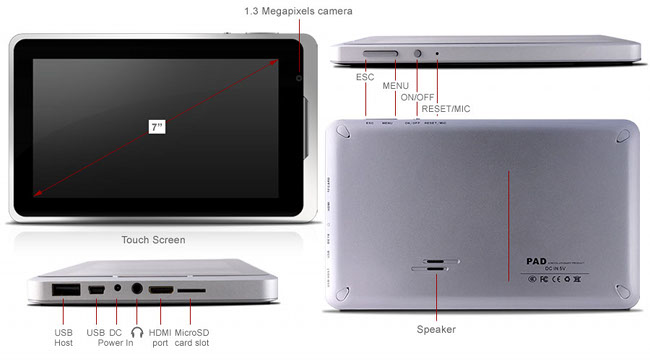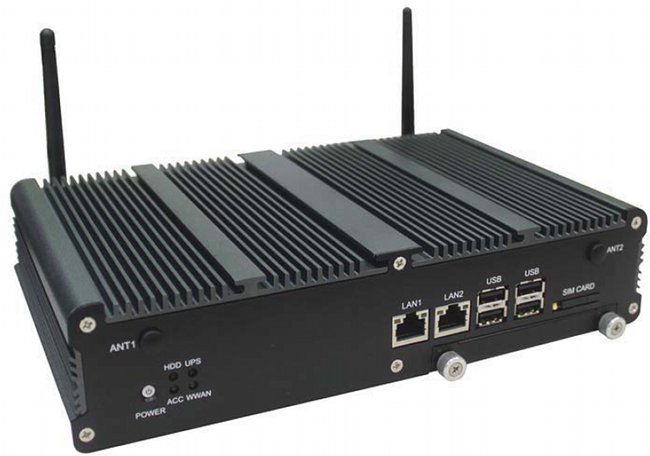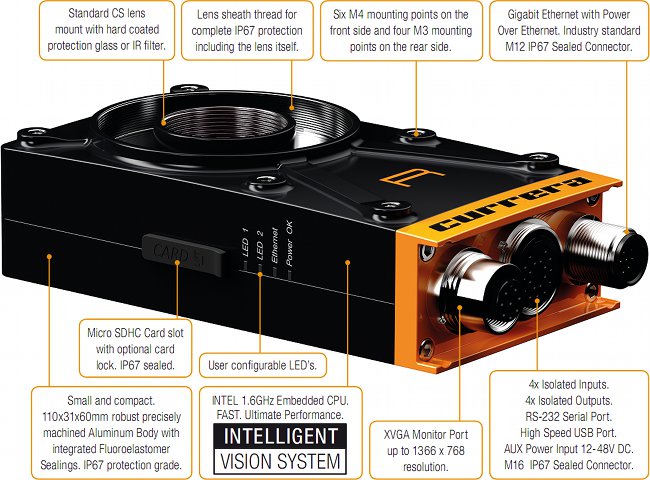Back in January 2011, Freescale announced the availability of its new i.MX 6 Processor series based on Cortex A9 with sample delivery at the end of 2011. Freescale has now revealed that First International Computer (FIC) – 大眾電腦 – a Taiwanese company – has adopted Freescale Semiconductor’s i.MX 6 series microprocessors for use in tablet PCs at the 2011 Freescale Technology Forum China on August 30. FIC will use Freescale’s i.MX 6 MPUs in its new line of tablet PCs with a price target sub-200 USD in order to differentiate itself from major competitors. The Freescale i.MX 6 is based on the ARM Cortex-A9 architecture running at up to 1.2 GHz and come in single core (i.MX6 Solo), dual core (i.MX6 Dual) and quad Core I.MX6 Quad). Currently there are no further information on the FIC tablet specifications. Jean-Luc Aufranc (CNXSoft)Jean-Luc started CNX Software in 2010 as a part-time […]
Wyse Announced Two Linux Thin clients: Z50S and Z50D
Wyse Technology announced that its fastest thin clients ever, the Z90D7 and Z90DW are now shipping at VMworld 2011. You can have a look at AMD Embedded G-Series mini-PC, motherboard and thin client for details about the devices. In addition, Wyse also introduced two new Linux-based members of its Z class family – the Wyse Z50S and Wyse Z50D. Both thin clients run Wyse Enhanced SUSE Linux Enterprise. The press release also indicated that “the Z50 thin clients are built on the same exact advanced single and dual core processor hardware platform as the Wyse Z90 thin clients, the upcoming Linux-based Wyse Z50 promises more of the same industry leading power and capability on an enterprise-class Linux operating system”. Wyse did not provide further details but based on the statement above, we can probably safely assume that Z50S will use the single core AMD G-T52R and the Z50D will be […]
Linaro 11.08 Release with Linux Kernel 3.0.3
Linaro has just released version 11.08 based on Linux Kernel 3.0.3 with support or TI Beagleboard, BeagleBoard-xM & Pandaboard, ST Ericsson Snowball, Freescale i.MX53 development board and Samsung Origen board. Here are the highlights of the release: Android The Linaro 11.08 toolchain release of GCC 4.6 has compiled the Origen, BeagleBoard, BeagleBoard-xM, PandaBoard and Snowball builds, and are running Android 2.3.5 with a 3.0 Linux kernel. Together with the mainline kernel focused builds for BeagleBoard and PandaBoard and a preliminary i.MX53 build, the Android Platform Team ships 6 builds this month. A first! Android Platform code aliasing violations have been fixed allowing the use of strict-aliasing for better optimizations with gcc 4.6 based toolchains. The Android toolchain 11.08 has been released and has received numerous updates, including updated binutils and current gmp/mpfr/mpc. Benchmarks are available here. libjpeg-turbo 1.1.1 and ffmpeg with support for H.264 and WebM build are available on […]
X10 AirPad: 200 USD Android 2.3 Tablet powered by Rockchip RK2918
X10 has started to sell its own android tablet for 199.99 USD. The X10 AirPad is powered by Rockchip RK2918, a 1.2GHz, Cortex-A8-based processor, 512 MB RAM and 4GB of flash storage, and runs Android 2.3 (gingerbread). It features a seven-inch, 800 x 480 pixel capacitive display, a 2 MP camera and an HMDI output supporting 1080p. Its specifications are similar to Arnova 7 G2 also powered by RK 2918 @ 1 Ghz, the second version of Arnova 7 that runs Android 2.3 and features a 7″ capacitive display and is said to be sold in Hong Kong for around 215 USD. Here are the X10 AirPad 7″ Android Tablet Specifications: CPU: 1.2 Ghz Rockchip 2918 Cortex A8 processor + 600 Mhz DSP Display: 7″ 800×480 resolution TFT LCD screen Touch-screen: Capacitive multi-touch, 5 point touch OS: Android 2.3, with Flash 10.1 Camera: 2 Megapixel camera with video recording and […]
LinuxCon 2011 Presentation: Embedded Systems
The fourth presentation entitled “Embedded Systems” was presented by Tim Harder, developer at OSUOSL (Oregon State University Open Source Lab) on the 16th of August 2011 at LinuxCon 2011. Abstract: This presentation deals with software development for Embedded Systems especially focusing on Linux and open source. It describes current software development challenges such as fast software life cycle and memory footprint issues, lists several open hardware projects (Beagleboard, Pandaboard, Bug Labs, Gumstix), microcontrollers (Arduino and TI MSP430), different operating systems (Android, Meego) and toolchain build tools (Buildroot, Yocto) for embedded systems. It also explains specific challenges to embedded software development such a the numerous number of hardware platforms and software & hardware tools. Finally, it deals with the cross-compilers, emulators (e.g. qemu) and debugging tools (gdb, jtag, serial console, etc…). If you want to download the presentation slides, please go to Embedded Systems and use the download button on top of […]
AMD G-Series Vehicle Computer: Portwell PCS8277
Portwell announced a vehicle PC (The PCS-8277) that features an AMD G-Series processor (T56N), 2 bays for SATA devices, 2 gigabit Ethernet ports, 2 USB port, support for wireless networking (3G, Wifi etc..) and a GPS receiver. This type of device is well suited for applications such as digital signage in public transport (subway, buses). PCS-8277 In-Vehicle PC has the following system and I/O specifications: CPU: AMD G-T56N Dual Core 1.6GHz System Memory: 2 x DDR3 1066MHz SO-DIMM up to 8GB Chipset: AMD A55E Controller Hub lrDA: IrDA (SIR, Consumer IR) with TTL level Audio: Realtek ALC662 HD Codec onboard Expansion: 2 x 2.5” drive bay for SATA Type Hard Disk Drive / SSD SIM Card Socket: 1 x SIM Card socket supported onboard with eject MIO: 3 x RS-232 (2 with RS-422/485) DIO: Port 4 in and 2 out with Relay 12V / 80mA USB: 4 x USB 2.0 […]
AMD G-Series based Ximea Currera-G Smart Camera running Linux
Ximea, a company based in Germany, announced a new version of its Currera Smart Camera: the Currera-G based on AMD G-Series APU. Here’s an excerpt of the press release: The CURRERA-G Smart Camera from XIMEA GmbH, manufacturer of industrial, smart camera, and scientific imaging equipment, sets a new standard for machine vision smart camera processing power. The CURRERA-G Smart Camera houses a single-board-computer built around AMD’s new Fusion accelerated processing unit (APU), which combines the power of both CPU and GPU cores on a single die. “AMD’s Fusion processor means the CURRERA-G can deliver 90Gflops of processing power to tackle the toughest machine vision system applications,” says Vasant Desai, XIMEA Co-Founder and Managing Director. “Combining GPU cores on the same die as the CPU enables the heterogeneous system to offload computation intensive pixel data processing from the CPU to the GPU. Released form this task, the CPU can serve I/O […]
What is GENIVI ? A Software Standard for the Automotive Industry
I’ve recently read in the news that a few operating systems had achieved GENIVI compliance. So let’s see what Wikipedia says about the GENIVI Alliance: The GENIVI Alliance was founded on March 2, 2009 by BMW Group, Delphi, GM, Intel, Magneti-Marelli, PSA Peugeot Citroen, Visteon, and Wind River Systems with the goal of establishing a globally competitive, Linux-based operating system, middleware and platform for the automotive in-vehicle infotainment industry. Since then, the alliance has expanded to more than 100 members who are working together to deliver an open and globally consistent software platform based on Linux for use by the whole car industry. So the clear goal here is to have some set of software specifications and standards (Currently GENEVI 1.0) in the automotive industry in order to speed time to market and reduce the cost of developing Infotainment applications. GENIVI comes from a concatenation of Geneva and IVI (In-Vehicle […]








